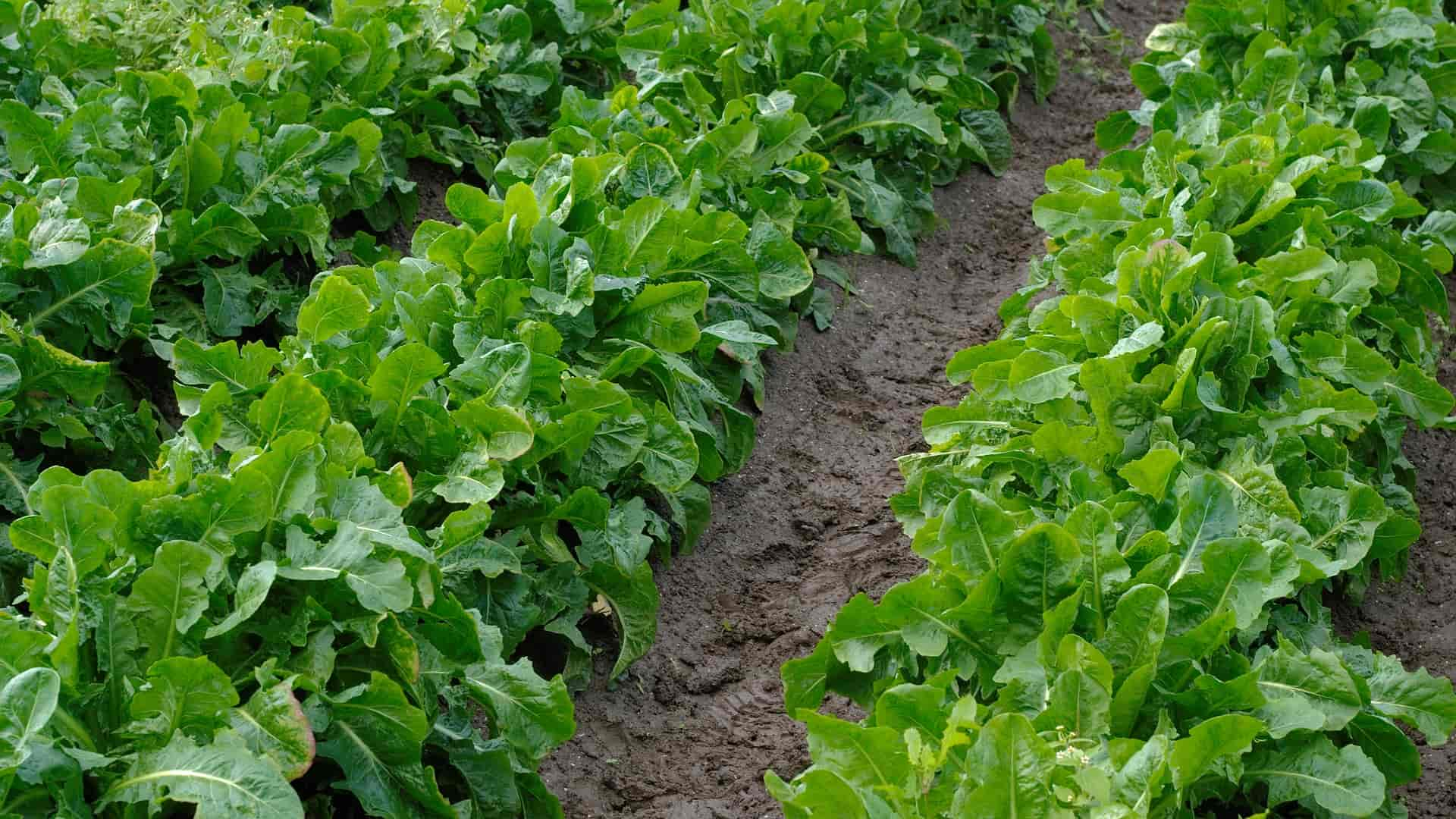
Chicories: sowing, growing and harvest
Contents
Chicories in a nutshell
- Chicory (Cichorium) is a botanical genus in the family Asteraceae that includes a multitude of wild or cultivated species. All are characterised by a certain bitterness.
- Some chicories (Cichorium endivia) are grown for their leaves (curly chicory and escaroles), while others (Cichorium intybus) are primarily cultivated for their roots (endives and bitter chicory). However, this latter subspecies also contains varieties valued for their leaves.
- These are herbaceous perennial plants whose medicinal virtues were already known to the Greeks and Egyptians.
- Chicories mostly have azure blue flowers that bloom from July to September.
- Many of these cultivated chicories need to be deprived of light in order to blanch and attenuate their bitterness.
A word from our expert
Exploring the botanical genus of chicory (or rather chicories) is sure to give you a headache! Indeed, when we talk about chicory, there’s just as much to drink as there is to eat! We all know the slightly bitter drink (even if we haven’t tasted it…), a coffee substitute that is very popular in the North of France. This industrial chicory comes from the root of a variety of Cichorium intybus, a robust herbaceous plant with lovely azure blue flowers, which also includes Monk’s beard, Sugarloaf, the Italian chicories with all-red leaves, and even endive.
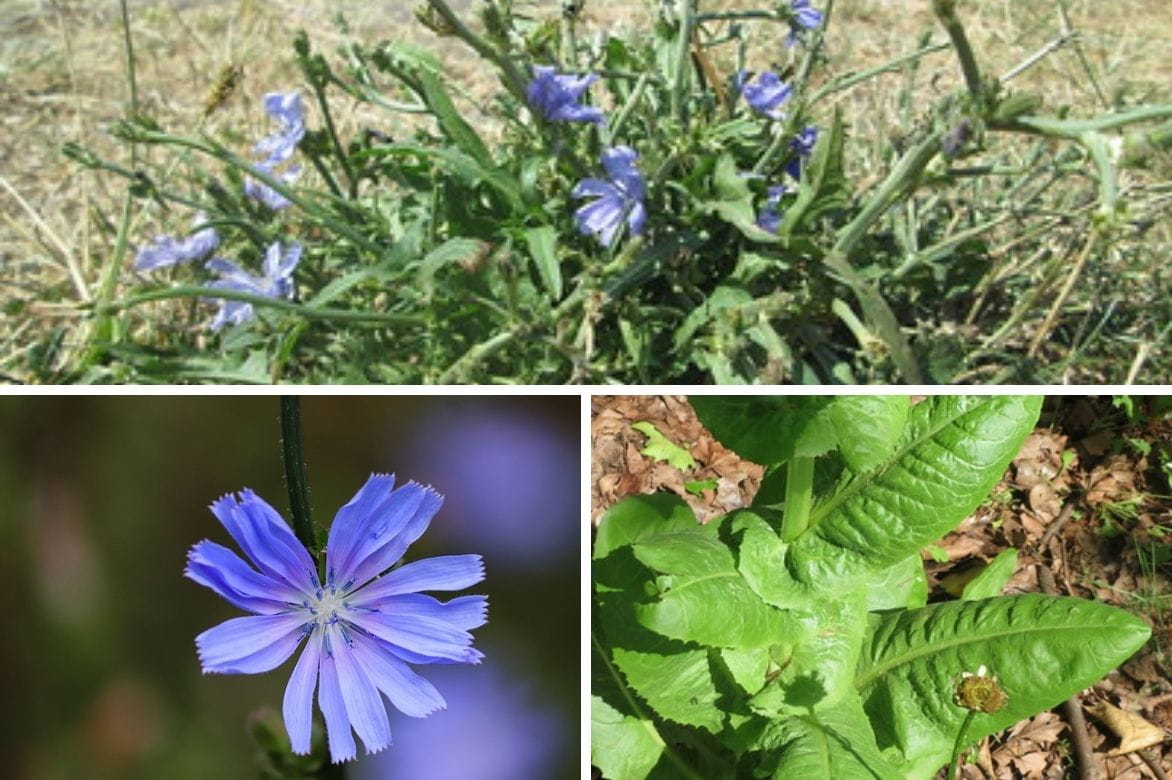
The wild chicory (Cichorium intybus) grows naturally along paths and in uncultivated fields
This same endive (known as chicon in the North and Belgium) whose roots are forced and blanched, is a wild chicory that has been hybridised for cultivation… Logically, one might think that our endive comes from Cichorium endivia. Well, not at all! In this botanical variety of cultivated chicory, we find escaroles and frisée, these salads that have been grown since antiquity and are quite resistant to the cold. Recognisable by their more or less dentate leaves, they all have a slightly bitter flavour. They too sometimes need to be blanched.
Feeling lost? That’s normal… But with a little concentration, everything becomes clear. I invite you to enter with me into the wonderful world of chicory to understand how a plant can be enjoyed both as a hot drink and as a salad with vinaigrette.
Botanical description
Botanical data
- Latin name Cichorium
- Family Asteraceae
- Common name chicory
- Flowering summer
- Height variable
- Exposure full sun
- Soil type Well-drained, rich soil
It all starts with the genus Cichorium. This famous chicory, whose history is somewhat lost in the mists of time. Prehistoric people certainly included it in their diet, but it is in the Ebers Papyrus, dated to the 15th century BC, that chicory is mentioned as a medicinal plant. Already, a distinction is made between wild field chicory and cultivated garden chicory. From the former, the root is used primarily for its therapeutic properties, while from the latter, the leaves are preferred.
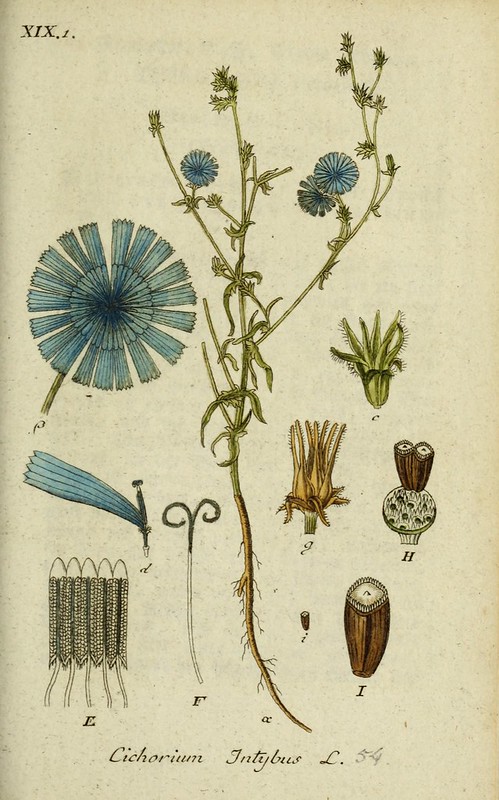
Botanical illustration
Later, the Greeks and Romans also greatly appreciated this chicory, primarily for its therapeutic virtues. However, all cultivated varieties mainly stem from wild chicory. Meanwhile, garden chicory is neglected as it is deemed too bitter. Charlemagne included it in his Capitular of Willis, listing all the plants worthy of a place in the gardens of castles. It appears again later in the Codex.
Botanically speaking, chicory belongs to the very large family of Asteraceae (composite flowers), which includes no fewer than 20,000 different species. And the genus Cichorium itself is subdivided into two species: Cichorium endivia and Cichorium intybus. This is where confusion insidiously sets in… Cichorium endivia (Endive chicory), as its name does not indicate, includes escarole salads (Cichorium endivia var. latifolia) and frisée salads (Cichorium endivia var. crispum). Endive is not classified here but rather in the species Cichorium intybus (also known as wild chicory or bitter chicory), which also includes the chicories whose green or red leaves we consume (Sugar loaf, Capuchin beard, Treviso, and other beautiful Italian chicories) or even industrial chicories (Cichorium intybus var. sativum), whose roots are dehydrated, roasted, and crushed to make the hot beverage beloved by the Leroux brand.
Endive chicories (without the endive!)
The endive chicory (Cichorium endivia) has been cultivated since Roman antiquity but does not originate from a wild variety. Cultivated as a vegetable plant, native to the Mediterranean basin, this variety of chicory is considered “true endive” by botanists. It is an annual, self-fertile plant that forms two groups of cultivated varieties: frisée chicories (Cichorium endivia var. crispum) and escarole chicories (Cichorium endivia var. latifolium).
These are herbaceous plants with an erect habit and a taproot. For escarole, the leaves are alternate, slightly crinkled, with entire or dentate edges. Meanwhile, frisée presents narrow leaves, arranged in a rosette, strongly dentate, slightly pubescent or glabrous, and which become finer towards the top of the stem. Yellow at the centre, the leaves evolve to green towards the outside.
Wild or bitter chicories
Wild chicory or bitter chicory (Cichorium intybus) is a perennial herbaceous biennial with a fleshy, cylindrical taproot that has an upright habit. It stands on a single, branching, angular, and hairy stem. The basal leaves are cut, lobed, quite similar to those of dandelion, the middle leaves are entire and lanceolate, while the upper leaves form bracts. These bright green leaves are rough on the upper side and hairy on the underside. Some parts of the plant, particularly the roots and leaves, produce a very bitter white liquid. They are often found on the edges of paths, in perennial fallows, and in uncultivated fields.
From July to September, azure blue flower heads appear. They bloom at dawn and close at noon, unless the sky is overcast. A peculiarity that gives them the name “brides of the sun.” Then, scaly achenes with short egret-like tufts arrive.
The species Cichorium intybus includes varieties cultivated for their leaves and others for their roots. These multiple uses have led to the creation of numerous cultivars:
- The Capuchin beard: this is the authentic bitter chicory, cultivated for its cut foliage. It has a long straight root that can be forced in a cellar in winter. This results in the formation of long, etiolate, dishevelled, and pale leaves, but above all much less marked in bitterness. Of Italian origin, this chicory was widely cultivated in the 19th century near Montreuil, in the suburbs of Paris.
- The Sugar loaf, an improved wild chicory: this is another cultivated variety of wild chicory obtained from Cichorium intybus foliosum which gives, among other things, the endive. It gets its name from its tightly packed leaves that form a dense, hard head resembling a sugar loaf.
- Italian chicories: these are varieties of wild chicories of Italian origin with beautiful red coloration that appears in the first cold. Their head is much smaller but well packed, and their bitterness is very pronounced. Their leaves are marked by a wide white midrib.
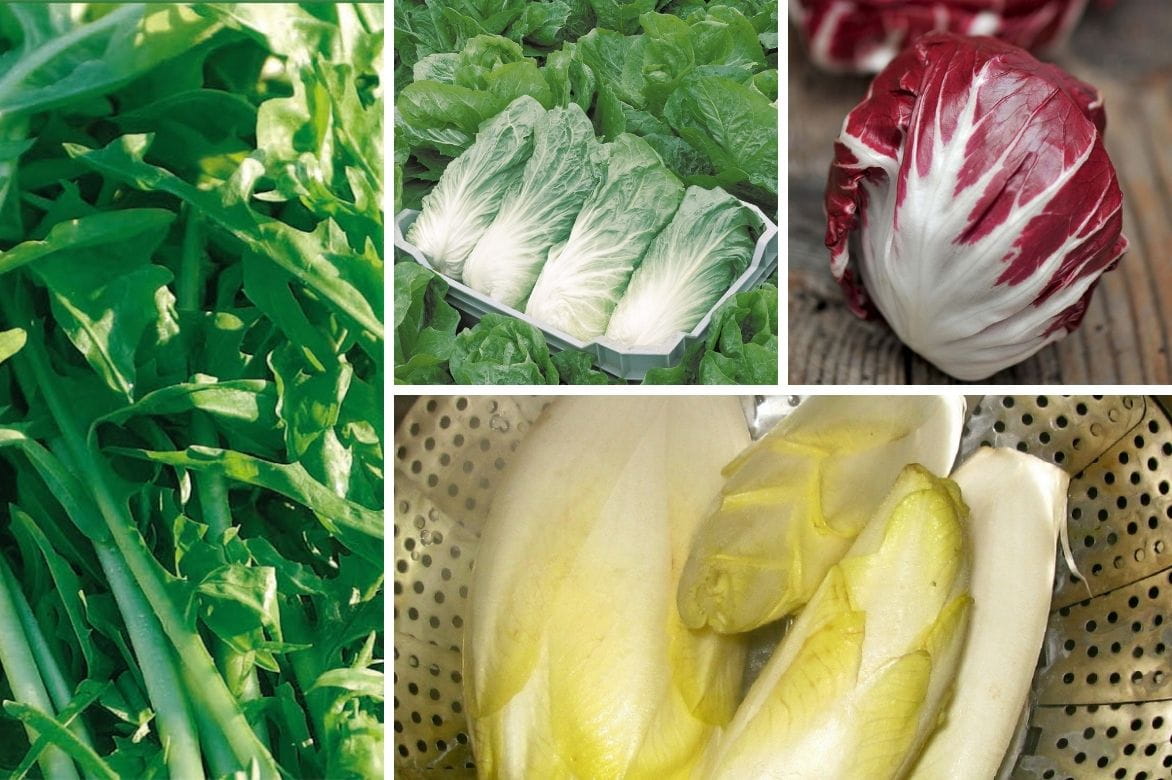
Capuchin beard, sugar loaf, Italian chicory, and endive
- The Witloof chicory or endive, also called chicon in the North. Cichorium intybus foliosum is cultivated to be forced to obtain beautiful pale, swollen shoots.
- The coffee chicory (Cichorium intybus var. sativum) is a bitter chicory cultivated industrially for its large root. Cut into chips or grated, dried, roasted, and ground, the root is used to make the hot beverage simply called chicory, very popular in Nord-Pas-de-Calais and Belgium. However, the most significant part of the production of this chicory is destined for the production of inulin, a sugar that transforms into fructose. As for the foliage, it feeds livestock.
Wild chicory has numerous medicinal properties, known since antiquity. The root or leaves are used, prepared as a decoction or infusion. It is known to improve digestive disorders. It is diuretic, appetising, sudorific, and stimulating. The roots prescribed in decoction treat liver disorders.
The different varieties of chicory
In the vegetable garden, we will focus solely on the cultivation of leaf chicories, most often used in salads. Whether they have long, undulating leaves with smooth edges or deeply cut like escaroles and curly chicories, dense heads like Sugar Loaf or endive, or tightly packed rosettes of red leaves, all chicories share a more or less pronounced common trait: their bitterness.
Escarole is a generous chicory. It forms a rosette reaching 30 to 40 cm in diameter, made up of broad, slightly undulating leaves that are particularly crunchy. This autumn and winter salad has a flavour marked by a hint of bitterness. The leaves soften after the first white frosts.
Our favourites
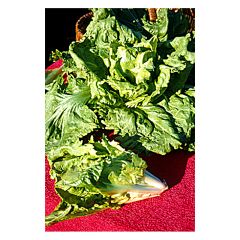
Escarole Cornet d'Anjou - Cichorium endivia var. latifolium
- Flowering time August to October
- Height at maturity 50 cm
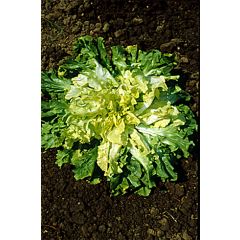
Escarole Géante Maraîchère - Cichorium endivia var. latifolium
- Flowering time August to October
- Height at maturity 30 cm

Escarole Blond Full Heart - Vilmorin Seeds
- Flowering time August to October
- Height at maturity 30 cm
These are tasty salads with widely cut and dentate foliage, grouped in a spreading rosette. Less hardy than escarole, curly chicory is more of a summer or autumn salad. To reduce the bitterness of its leaves, it needs to be blanched about ten days before harvest.
Our favourites
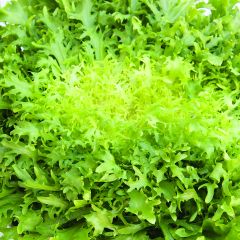
Curly Endive Fine de Meaux - Cichorium endivia crispum
- Flowering time August to October
- Height at maturity 30 cm
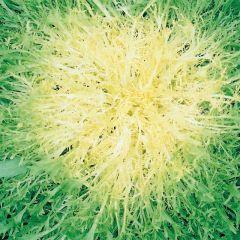
Cichorium endivia var. crispum Très Fine Maraîchère
- Flowering time August to October
- Height at maturity 50 cm
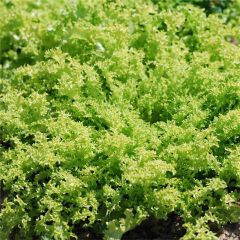
Frisée endive Grosse Pancalière - Ferme de Sainte Marthe seeds
- Flowering time August to October
- Height at maturity 50 cm
These chicories with beautiful red to purple foliage are very frost-resistant and occupy the vegetable garden all winter without real protection. Their heads, sprinkled with well-white midribs, are rather dense and tight but small. Ideal for autumn and winter harvests, they can regrow if the foliage is cut above the collar. Their flavour is bitter, which is why they are included in mescluns, adding colour.
Our favourites
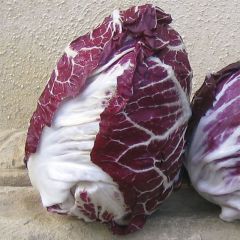
Chicory Rossa di Verona
- Flowering time August to October
- Height at maturity 50 cm
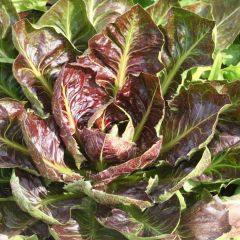
Chicory Rossa di Treviso
- Flowering time August to October
- Height at maturity 50 cm
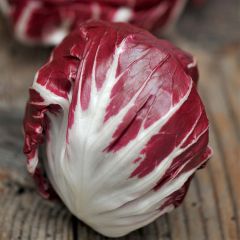
Chicory (Radicchio) Palla Rossa 3 - Ferme de Sainte Marthe Seeds
- Flowering time August to October
- Height at maturity 50 cm
It is specifically the Witloof chicory (which means “white leaves” in Flemish) that produces well-white endives. The cultivation of this variety, derived from Cichorium intybus var. foliosum, is relatively recent, dating back to 1850. It is a creation attributed to Mr. Bréziers, head gardener of the Belgian Horticultural Society, who obtained this spindle-shaped salad by placing some wild chicory plants in sand.
This particular cultivation of endive goes through three distinct stages: sowing the roots in open ground in May, followed by harvest between September and November, forcing in darkness to obtain an hypertrophied bud, and then breaking, which involves separating the shoot from the root.
Our favourites
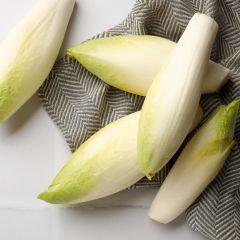
Witloof Chicory Normale Maraîchère
- Flowering time August to October
- Height at maturity 30 cm
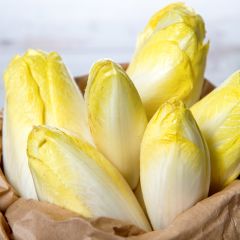
Witloof Chicory Crénoline F1 - Vilmorin Seeds
- Flowering time August to October
- Height at maturity 1,50 m
This wild chicory with shaggy leaves grouped in a rosette is very bitter if consumed as is. It is therefore obligatory to force it, just like endive, in warmth and darkness. Another method involves forcing it outdoors in a mulched trench, under an opaque mini-tunnel. This forcing allows for the production of young pale leaves, finely dentate, which are significantly less bitter.
Our favourite
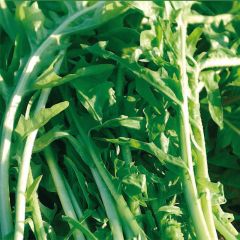
Chicory Monk's Beard - Cichorium intybus
- Flowering time August to October
- Height at maturity 50 cm
These chicories are very old varieties that form long, tightly packed, white-green heads. The leaves curl to form a cone that can reach 40 to 60 cm in height. They whiten naturally. It is a crunchy salad, consumed raw or cooked, with a mild flavour. It is frost-resistant, which actually enhances its flavour, and is harvested in autumn and winter.
Our favourite
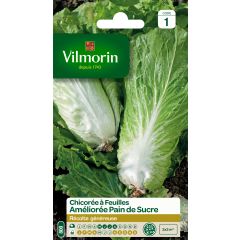
Sugarloaf Chicory Improved - Vilmorin seeds
- Flowering time August to October
- Height at maturity 50 cm
Discover other Endive
View all →Available in 1 sizes
Available in 1 sizes
Available in 1 sizes
Available in 1 sizes
Available in 1 sizes
Available in 1 sizes
Available in 2 sizes
Available in 1 sizes
Available in 1 sizes
Sowing chicories
What soil and exposure do chicories need?
Most chicories, particularly those of the species Cichorium intybus, have a taproot that penetrates deeply. This is why they require deep, well-loosened, and non-stony soil for endive, rich in well-decomposed organic matter. However, endive does not appreciate excess nitrogen. This soil should also be cool but well-drained, as chicories do not like humidity.
As for the nature of the soil, it matters little to chicories. It can be neutral and ordinary, or even slightly acidic or clayey.
Chicories thrive in a sunny location, especially when the young plants emerge from the soil. However, in the height of summer, some varieties of chicories cannot tolerate excessive heat. Therefore, the shade from other vegetables will be beneficial. You can also sow in partial shade, provided the location is not too cold.
When to sow chicories?
Depending on the species, chicory sowing takes place from May to August, knowing that germination occurs at temperatures ranging from 15 to 20 °C. Sowing under cover is always possible, but direct sowing in open ground is better to avoid premature flowering and thus bolting. Thus, escarole and curly chicory are ideally sown from mid-May to mid-July, and from mid-July to mid-October for early winter production. Improved Sugarloaf chicory is sown from March to June, while Italian chicories are sown from June to August. As for endives, it is recommended to sow them in May or June for a harvest scheduled from November . The sowing period for Capuchin Beard is longer, extending from April to August.
How to sow and transplant chicories?
In general, chicory sowing is done in rows spaced 30 to 40 cm apart.
- Carefully weed the soil and remove any stones that may remain.
- Loosen the soil using a rake or a broadfork.
- Add well-decomposed organic matter.
- Trace furrows 1 cm deep.
- Sow sparsely and cover with a thin layer of soil or sieved compost.
- Water using a watering can.
Germination occurs in 3 to 5 days in open ground. Beyond that, there is a risk of bolting. Additionally, a temperature between 15 and 20 °C is required for proper germination.
After approximately 3 to 4 weeks, it is necessary to thin out to every 10 cm for endives and every 30 cm for other chicories. The seedlings removed can be transplanted at the same distances.
Read also
15 salads for summerWhat care do chicories need?
Chicories appreciate regular watering, especially during hot and dry periods. This is how you will produce salads with tender leaves. However, avoid getting the foliage too wet, especially when blanching them. To space out watering, feel free to mulch the soil around the salads with a good layer of straw or ferns. This mulching will also have the advantage of protecting late chicories, such as certain escaroles or curly chicories, from autumn or winter cold. If the cold is particularly harsh and frosts are strong, applying a winter cover is recommended.
Chicories do not appreciate competition from adventive plants at all. It is therefore necessary to hoe and weed regularly. Furthermore, these hoeing and weeding activities aerate the soil and facilitate water penetration.
Moderately greedy, chicories are not averse to a small addition of well-decomposed homemade compost.
Bleaching and harvesting chicories
Not all chicories are created equal. Some can be harvested as they are, while others require blanching to remove bitterness, and some need forcing.
Escaroles, curly or Italian chicories, as well as ‘Sugar Loaf’ chicories, are harvested from late summer, depending on the varieties, as needed, preferably in the morning during warm weather. The harvest will continue until the heart of winter for the most cold-resistant chicories. To harvest a chicory, simply cut the plant with a sharp knife. The escarole and curly varieties should be well-spread, while the others form a compact head.
If you are concerned about the bitterness of these salads, it is possible to blanch them.
Blanching for less bitterness
Some chicories become sweeter, more tender, and crunchier if the central leaves are blanched. This is the case for curly chicories and escaroles, whose hearts are deprived of light (and therefore chlorophyll). The blanching process varies depending on the species.
For escaroles and curly chicories, this blanching operation takes place about ten days before the harvest. To do this, simply tie the leaves together using a piece of raffia, string, or an elastic band. However, this method has several risks: the heart can rot if the tying is done in humid weather. It is therefore preferable to carry out the blanching in dry conditions. The second risk lies in the presence of slugs, which, trapped in the centre of the salad, will have a feast worthy of a Christmas dinner. Be sure to check that no slugs are hiding in the leaves before tying them up! And above all, stagger the blanching to avoid having to eat all your salads at once. However, blanching is not recommended during freezing periods.
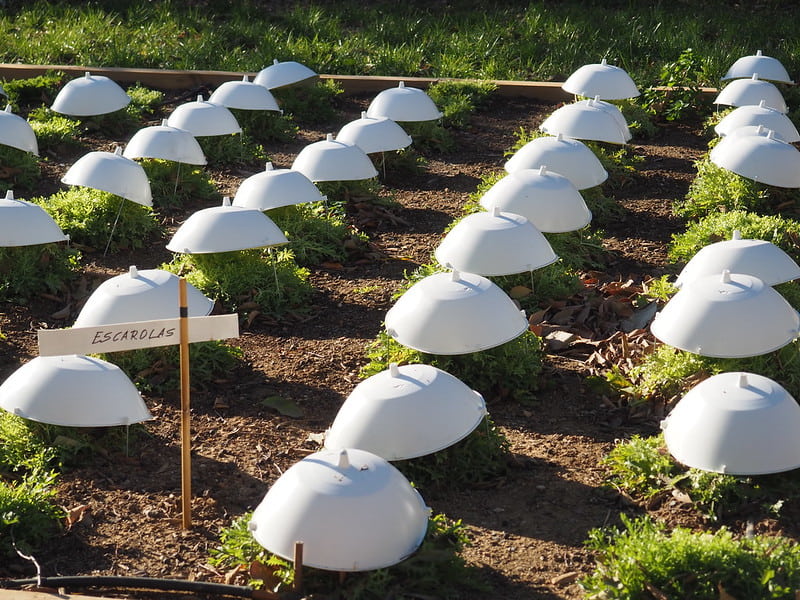
Escaroles can be blanched to reduce their bitterness
To address these issues, you can simply cover your chicories with either inverted pots or special bells. These techniques limit the risk of rotting. However, remember to block the drainage hole of the pots! If you have a large production of curly chicories and escaroles, you might also consider investing in an opaque mini-tunnel, although setting it up can be complicated.
Are you apprehensive about blanching your chicories? Ingrid explains everything in her advice sheet Succeed in Growing Chicory and Blanching It.
Forcing and harvesting chicory and its relatives
In October or November, it is time to lift the roots of the endive and beard. It is best to do this in damp weather to facilitate lifting, which is done with a digging fork.
- Insert the digging fork far enough from the roots to avoid damaging them.
- Leave the roots to dry on the soil for one to two days. They will not be harmed by light frosts.
- Once the roots are well dried, select the straightest, largest, and healthiest ones.
- Cut the leaves to 1 to 3 cm above the collar.
- Place all the roots at the same height in a polystyrene container, a wooden crate, or a plastic box filled halfway with a thin layer of universal potting soil mixed with well-aerated garden soil and sand. Arrange them side by side without overcrowding.
- Water generously.
- Cover the roots to keep them in the dark.
- Store your container in a cellar, pantry, garage, or garden shed at a temperature between 12 and 15 °C.
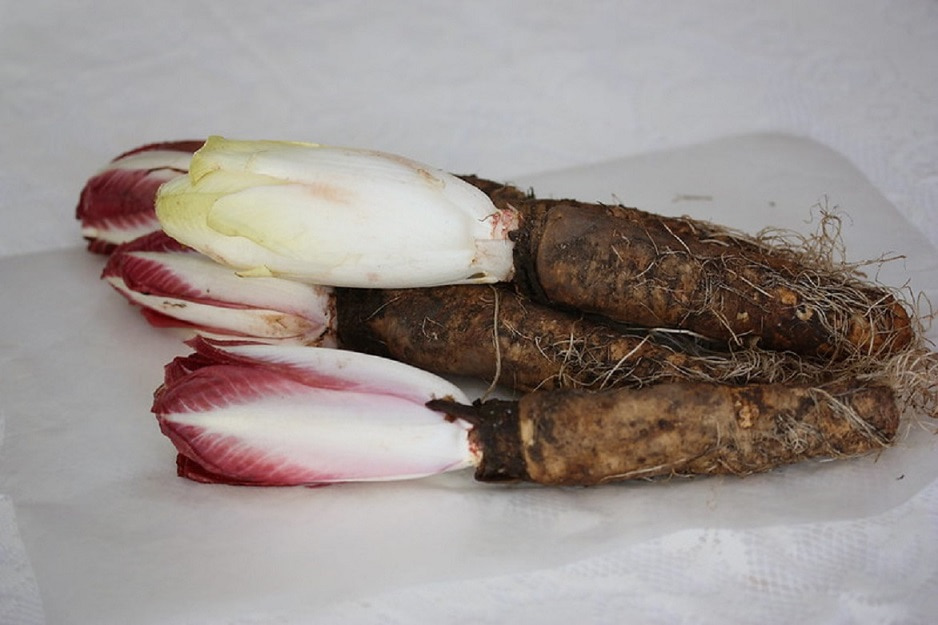 Harvesting endives after forcing[/caption>
Harvesting endives after forcing[/caption>
Depending on the forcing conditions and temperature, the first endives and beard chicories can be harvested three weeks after placing them in the container. By staggering the forcing, chicories can be harvested throughout the winter, until early spring. Harvesting endivette is also possible. After the normal harvest, continue watering the roots left in place. More chicons will form, smaller but just as delicious.
Discover our tips: Succeeding in growing endive
The enemies of chicories
The main enemy of chicories, and by far the most voracious, is the slug. It feasts on the young plants that have just emerged from the soil. To keep them away, you can sow wood ash or crushed eggshells. You can also place copper filaments or anti-slug barriers around your vegetable beds to deter them without killing them.
The cutworm or grey worm can also attack chicories. Blackbirds love them, but if their presence is not enough to eradicate them, remove the larvae during hoeing. A spray of tansy decoction should also help you get rid of them.
Chicories are not exempt from attacks by fungal diseases such as botrytis (grey mould) or downy mildew. To prevent the onset of these diseases, it is best to water without wetting the foliage.
→ Also read: the diseases and pests of salads
In the company of chicories...
In general, chicories enjoy the company of spinach, rocket, carrots and beetroot, beans, and lettuces, but dislike being near cabbages, celery, and turnips.
Uses of chicories
Obviously, escaroles, curly chicories, endives, and other sugarloafs are delicious in salads due to their crunchy leaves. Their slight bitterness is also an asset. The white leaves at the heart of the escaroles and curly chicories are delightful with an olive oil vinaigrette. Escarole pairs well with beetroot, cheese, smoked salmon, citrus trees, or dried fruits like hazelnuts. Meanwhile, curly chicory enjoys the company of hard-boiled eggs, lardons, and walnuts. And let’s not forget the little croutons!
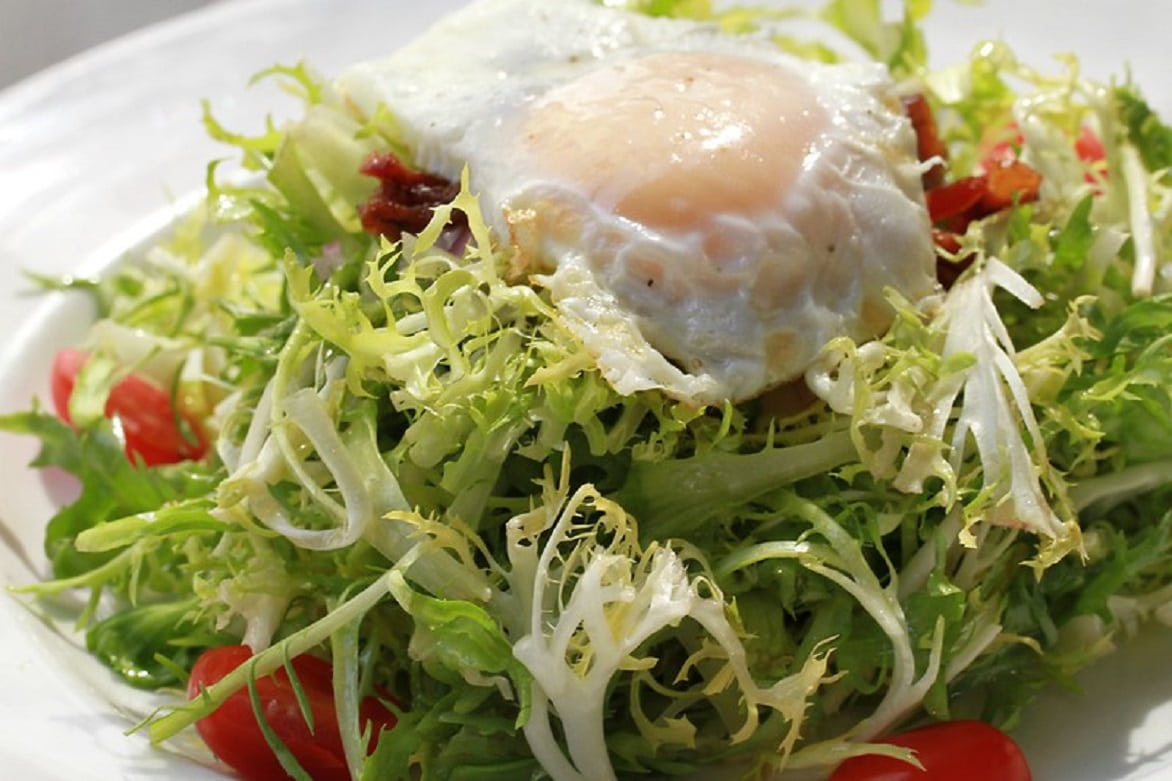
Curly chicory salad
The green outer leaves, which are more bitter and less tender, can be steamed or boiled to accompany meat, fish, or incorporated into a soup. Thus, the recipe for Neapolitan escaroles is a classic of Italian cuisine. Curly chicory is steamed for 2 to 3 minutes and is included in a soup’s composition.
Endives can be enjoyed raw in salads or cooked with ham and béchamel, or braised to accompany meat, scallops, etc.
The lovely Italian chicories are also eaten in salads, in mesclun with other greens, with cheese, pears, or apples, with cured ham, or with walnuts or hazelnuts. They can also be braised or sautéed with mushrooms in a pan. In Italy, they are often incorporated into risotto.
Sugarloaf chicory is excellent in salads, but its size makes it an ideal salad for cooking. It can be finely sliced and sautéed in a pan or wok, prepared as a gratin with béchamel, or even made into a tarte tatin or stuffed.
As for capuchin cress, it can be eaten raw in salads or cooked in a sauté with potatoes and lardons, in a gratin, or braised.
For further reading
- What if you were tempted by the lovely sky-blue flowering of wild chicory that grows everywhere? Discover it in pictures
- Check out our tutorial on Chicory: cultivation, benefits, and use
- Find out how to grow salad, including chicory, in pots
- Learn more about sowing endives or chicons with Olivier
- How to blanch winter lettuces?
- Subscribe!
- Contents































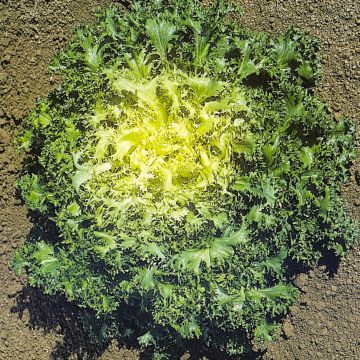
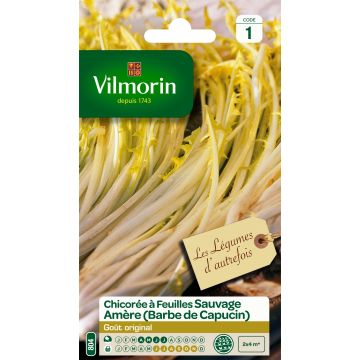

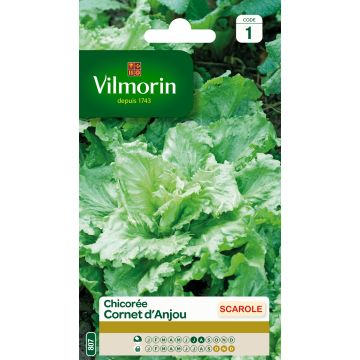
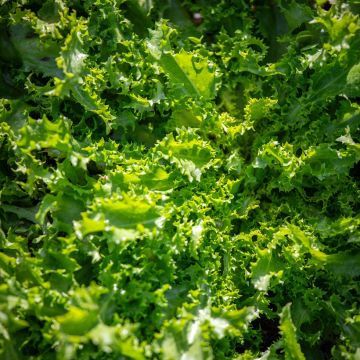

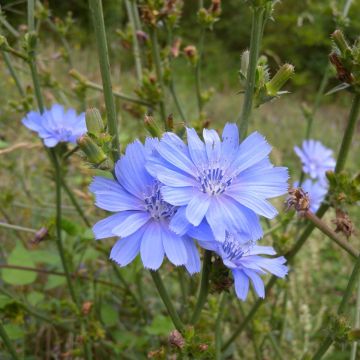

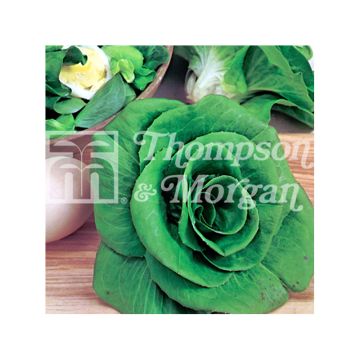
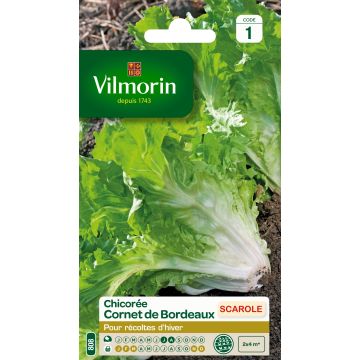
Comments